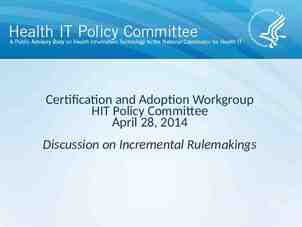Threat Perspectives From a consulting and a financial services view
27 Slides5.50 MB
Threat Perspectives From a consulting and a financial services view Jacky Fox & Gina Dollard
Threat perspectives Author name her l ca cti Ta Immediateuse use Long Longterm term Immediate use S use tra te gic What is Cyber TI and how can you use it? Attacker methodologie s and tactics. Architects and Admins Details of specific incoming attacks. Defenders Indicators of specific malware. SOC staff Op er ati o na l HighLevel Level High High Level Te ch ni ca l High level information on changing risk The board LowLevel Level Low Low Level Definition - Threat intelligence is evidence-based knowledge, including context, mechanisms, indicators, implications and actionable advice, about an existing or emerging menace or hazard to assets that can be used to inform decisions regarding the subject's response to that menace or hazard. Gartner 2013 Expectation - Understanding the threat landscape from a dynamic and strategic perspective helps an organisation to prepare for and react appropriately to Cyber events
Threat perspectives Author name her Some Current Challenges TI is poorly understood e.g. threat feeds vs threat intelligence Immature partial implementations – a lot are missing information sharing and strategic input Application of TI needs a lot of human input we are a long way from fully automated TI Security is viewed as an overhead so all initiatives need to have KPIs that show value Noise reaction required? Yes/None/Urgent
Threat perspectives Author name her Operational information & intelligence feeds Internally generated Analysis IOC hunters – Darktrace End Point Protection Information sharing Sectoral – Financial services, public sector Security Operation Geographic – local CERT Vulnerability Management NIS Directive Generic external Organisation specific Open source Branded “mybank” information Subscription based - X-Force, Digital Shadows, Deepsight Social media Boards Raw e.g. XSS Dark web Indicators of compromise (IOCs) Tactics techniques and procedures TTPs Customer or organisation phishing campaigns .
Threat perspectives Author name her Use case examples Threat Analysis Phishing detection Incident Response knowledge base Projection Collection Disseminatio n Processing Vulnerability prioritisation Brand monitoring Fraud detection Validation Analysis & Production
Threat perspectives Author name her Organisation-specific Attack Based Threat Hunting Hypothetical scenario Login to a cloud service from a non-corporate device to steal data Predict and estimate the footprint Produce Unusual IP/Machine name/OS/Geolocation/time/volume/authorisation failures/upload Enact or hypothesise and gather artefacts Inspect logs, ID markers, registry Block/Alert/Pass? CEO new phone? Attacker stealing data? Brute force attack? Learnings Additional logs, if only we had blocked file downloads from new Geolocations Custom IOCs
Threat Perspectives Sources: Deloitte Threat Intelligence & Analysis program Author name her LEVEL OF CONCERN HIGH TOP ATTACK VECTORS GDPR compliance Unaddressed Software Ransomware Vulnerabilities takes applications hostage NOTABLE CYBER SECURITY EVENTS Legacy technology is susceptible to attack. Ransomware disrupts businesses globally. Unaddressed software vulnerabilities can weaken TOP ADVERSARY GROUPS Nation state entity Social engineering Legacy technology fails to provide adequate protection and stability in the face of new attacks LOW Phishing Data breach Malware targeting company devices or applications to reach clients MED Malware Ransomware Organized crime groups Disruption of Communications (DDOS) Network Devices Misconfiguration Firewall Misconfiguration Corporate espionage groups Insider Exploit Botnets kits Physical actions Cyber Web espionage Application Data Attacks breaches Spam Hacktivists Script Kiddie Lone-wolf cyber criminals Researcher/ journalist KEY TAKEAWAYS Threat actors develop capabilities and change their attack vectors to take the least difficult approach into your company. For this sector we observed high profile actors targeting for monetary gain, while hacktivism focused on disruption. Tracking industry trends can assist in understanding attack vector changes and form
Threat perspectives Author name her Putting some of the pieces together (not exclusive) Real Threat Intelligence? Existing RCMs Control information, risk treatment and residual risk register IR Playbooks External, generic and organisation specific playbooks, MITRE framework Strategic threat analysis Actors, Vectors and scenarios Threat Intelligen ce Critical Asset register Value based list of critical assets prioritised to be able to inform threat actions VM programme Penetration & vulnerability management data, patch lag information Operational information Information feeds, generic IOCs, specific, sectoral, threat hunt IOCs
TIBER-EU A brief introduction
Threat Perspectives ECB May 2018 What is TIBER-EU? Threat intelligence based ethical red teaming. Production systems Identify critical functions e.g. payment services, ATMs Mimic tactics, techniques and procedures of real actors insiders or external Each regulator can decide to use –EU or to localise TIBER-NL Input from tiber-nl (November 2017) & CBEST Avoid repeated tests from different bodies via mutual recognition Don’t give a pass or fail status – just findings to provide insight and improve posture Financial stability of greater EU economy Oversight mechanism The benefit of cross jurisdictional testing accepted across borders by way of mutual
Threat Perspectives Who is involved? Must be conducted by independent third parties not internal red teams A test involves the entity, regulator, external threat intelligence and external red team Blue team (who don’t know the test is being conducted) White team – internal PM type role Financial sector entities definition for TIBER-EU: Payment systems, Central Securities depositories, central counterparty clearing houses, trade repositories, credit rating agencies, stock exchanges, securities settlement platforms, banks, payment institutions, insurance companies, asset management companies and other critical service providers. Not limited to financial institutions
Threat Perspectives Preparation phase Scope determined and signed off by the board and the regulator Critical function identification/confirmation Identification of flags Qualified Threat Intelligence and Red teams procured? Tender process Confidentiality protocols Secure document transfer
Threat Perspectives Risk Management for TIBER-EU? Testing on production systems Qualifications of TI & RT providers Call out of activities that are not allowed during testing e.g. blackmail, bribing, uncontrolled CIA attacks Risk and control framework Clear escalation procedures and stop button Use of code names Footprinting risks when mimicking real life attack People reconnaissance Dark web Use of social engineering and under cover
Threat Perspectives Testing phase Threats: Generic Threat Landscape (TTPs, Actors & Vulnerabilities) – this can be produced by authorities, other agencies or third party, ISACs etc. and updated annually General Threat Landscape of national financial sector threat Targeted threat intelligence report to incorporate business overview, threat register & recent attacks TTI includes attack surfaces, actors & scenarios Estimated effort 5 weeks should be broad and deep input using e.g. OSINT and HUMINT This feeds into The red team test plan to inform the chosen flags and targets Reconnaissance –use of TI report and other footprinting Weaponisation – selection of tools for targets Delivery – launch Exploitation – actively breaking in, Ownership & lateral movement Always time limited so if roadblocks are met hints can be given Good governance and comms should be in place during the testing
Threat Perspectives Closure phase Red team preliminary test results report Blue team are informed of the test and a 360 view is analysed Remediation planning controls, policies, education etc. budgets Learnings
TI in practice Gina Dollard
Threat Perspectives So what does it mean? TIBER- EU Framework “Intelligence-led red team tests mimic the tactics, techniques and procedures (TTPs) of real-life threat actors who, on the basis of threat intelligence, are perceived as posing a genuine threat to entities. An intelligence-led red team tests the use of a variety of techniques to simulate an attack on an entities critical functions (CFs) and underlying systems (i.e. its people, process and technologies). It helps an entity to assess its protection, detection and response capabilities”
Threat Perspectives Threat Actor Capabilities Organized Criminals Phishing Malicious Insiders Commodity Malware Hacktivists Cyber Vandalism DDoS Reputational Damage State-Sponsored ‘APT’-style Attacks Custom malware/exploits Spear Phishing Insider Unintentional (Error) or intentional Malicious) Data Breach Lost/Stolen IP
Threat Perspectives Security Program Strategy & Governance Security Architecture Risk & Compliance Mgt. Threat Intelligence & Incident Mgt. Threat & Vulnerability Mgt. Identity & Access Mgt.
Threat Perspectives Kill Chain Analysis Task: Identify the Attackers’ Step by Step Process Goal: Disrupting Attackers’ operations Recon Motivation Preparation Weaponise Configuration Packaging Delivery Mechanism of Delivery Infection Vector Exploitation Technical or human? Applications affected Method & Characteristics Installation Persistence Characteristics of change Acquiring additional components C2 Communication between victim & adversary Actions & Objectives What the adversary does when they have control of the system
Threat Perspectives MITRE ATT&CK MATRIX Builds on the Kill Chain Provides deeper level of granularity Recon Motivation Preparation MITRE ATT&CK: Active Scanning Passive Scanning Determine Domain and IP Address Space Analyze ThirdParty IT Footprint Weaponise Configuration Packaging MITRE ATT&CK: Malware Scripting Service Execution Delivery Exploitation Mechanism of Delivery Infection Vector MITRE ATT&CK: Spearphishing Attachment/Link Exploit PublicFacing Application Supply Chain Compromise Technical or human? Applications affected Method & Characteristics MITRE ATT&CK: Local Job Scheduling Scripting Rundll32 Installation Persistence Characteristics of change Acquiring additional components MITRE ATT&CK: Application Shimming Hooking Login Items Actions & Objectives C2 Communication between victim & adversary MITRE ATT&CK: Data Obfuscation Domain Fronting Web Service What the adversary does when they have control of the system MITRE ATT&CK: Email Collection Data from Local System/Network Share
Threat Perspectives Layered Security Controls Recon Motivation Preparation MITRE ATT&CK: Active Scanning Passive Scanning Determine Domain and IP Address Space Analyze Third-Party IT Footprint Security Controls: Policies & Procedures Firewall Cyber Awareness Training Weaponise Configuration Packaging MITRE ATT&CK: Malware Scripting Service Execution Security Controls: Threat & Vulnerability Mgt. Delivery Exploitation Mechanism of Delivery Infection Vector MITRE ATT&CK: Spearphishing Attachment/Link Exploit Public-Facing Application Supply Chain Compromise Security Controls: Anti-Virus Web Proxy Mobile Device Mgt. Directory Services Technical or human? Applications affected Method & Characteristics MITRE ATT&CK: Local Job Scheduling Scripting Rundll32 Security Controls: Anti-Virus EDR IDS Installation Persistence Characteristics of change Acquiring additional components MITRE ATT&CK: Application Shimming Hooking Login Items Security Controls: Anti-Virus EDR Policies & Procedures Actions & Objectives C2 Communication between victim & adversary MITRE ATT&CK: Data Obfuscation Domain Fronting Web Service Security Controls: IDS Web proxy Firewalls EDR What the adversary does when they have control of the system MITRE ATT&CK: Email Collection Data from Local System/Network Share
Threat Perspectives Defensive Security Capabilities
Threat Perspectives Intelligence-led Testing Should be a nightmare! Help identify strengths and weaknesses Used to enrich Threat Intelligence
Threat Perspectives Get Real! Informed Stakeholders IT – fit issues, Security Teams – improve capabilities Invested Stakeholders Lessons learned Set expectations Advocate for investment
Threat Perspectives Where to next? Automation Improve speed Augment capabilities Orchestration Eliminate repetitive, mundane tasks Automate responses Prioritise security events
Threat Perspectives Getting it Right Defenders 100%: Attackers 1%
































